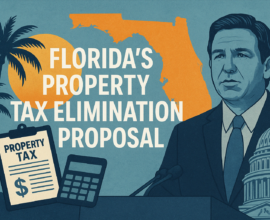Is Now the Time to Invest in Micro-Apartments?
As most major U.S. housing markets are seeing record-high prices combined with more people moving back into urban areas, the need for affordable and available housing is at an all-time high. Many believe that the new trend of micro-apartments might be an answer to the current housing situation. The question is whether micro-apartments are just a passing trend or a genuine opportunity for real estate investors.
What Are Micro-Apartments?
Currently, there is no standard definition for micro-apartments. It’s safe to say that they are typically single-room living spaces. The actual size of the living space is often determined by the specific market where it exists but is typically no larger than 350 square feet.
To put this in perspective, the average parking space in the U.S. is about 161 square feet. The largest micro-apartment would be just over two parking spaces in size, but not quite as large as a standard two-car garage.
While micro-apartments are single-room living spaces, they should not be confused with studio apartments. Realtors will often use these terms interchangeably since there aren’t formal definitions available. Some even take advantage of the micro-living trend and call their smaller listings micro-apartments to gain attention and interest.
Studio apartments are often known for their open and airy spaces. The kitchen, living area, and bedroom are all part of the same space. Residents use furniture and partitions to create separate areas. Most studio apartments are between 300 and 600 square feet.
A micro-apartment is a smaller version of a studio apartment. Micro-apartments are designed with efficiency in mind. They create an illusion of space and utilize space-saving elements in their construction. For example, Murphy beds, extendable tables, and convertible seating are all popular options for micro-apartment designs.
The other element that makes micro-apartments stand out from typical studio or efficiency apartments is the use of communal space. Micro apartment buildings can contain general communal spaces like kitchens, office spaces, and patios. Some of these buildings also offer more luxurious amenities like gyms, recreational areas, and rooftop gardens.
Why Are Micro-Apartments Trending?
It’s possible that micro-apartments are just a passing phase like Beanie Babies or Google Glass, but this trend doesn’t seem to be cooling down anytime soon. While the increased cost of housing might be an easy explanation for why people are looking for smaller, more affordable housing options, that’s not the whole story.
Another factor to consider is what many are calling the millennial effect. While the technical definition of a millennial is anyone born between 1981 and 1996, most people use the term to describe a young professional who has just entered the workforce. Many new entries into the workforce and real estate market corresponds with the rise of the popularity of micro-living options.
A survey conducted by the Urban Land Institute traces the rise in micro-unit demand back at least a decade. It also discovered that many young professionals want to choose where they live and work versus moving to wherever they can find a job.
Getting into the real estate market in more expensive and competitive cities can be nearly impossible for someone recently out of college with large student loan debts and less disposable income. Micro-apartments allow these individuals to move where they want and still be able to afford to live in a populous city center.
Besides recent college graduates and young professionals, there’s another type of tenant who is flocking to micro-apartments: retirees. Retirees like the idea of micro-living for many of the same reasons young professionals seek them: location, price, and communal living. Retirees also like being able to escape things like property taxes and mortgages during their golden years.
Are Micro-Apartments Good Real Estate Properties?
It’s easy to see why micro-apartments are ideal for renters looking to live in a great location on a budget, but what do they look like for investors? Whether you’re just starting in your commercial real estate journey or you’re looking for opportunities to expand your portfolio, here are some of the top reasons micro-apartments should be part of your investing strategy.
Location, Location, Location
There’s an adage that suggests location is everything when it comes to property. Micro-apartments are currently found downtown, in trendy hotspots, and near major amenities. You’re less likely to find micro-apartments in the suburbs, although it’s not impossible.
Renters value being in the right place so much that they’re willing to sacrifice some space to be there. Some of the most popular places for investors to purchase micro-apartment properties are in places like Los Angeles, Seattle, San Francisco, New York City, and Washington D.C. You’ll even find incredible opportunities on the global market in places like the UK, France, Germany, Italy, and Spain.
Lower Initial Investment
Since micro-apartments are smaller properties, they have relatively lower entry point costs for investors. Miami, for example, is seeing a surge in micro-apartment investments. Based on data from Related ISG Realty, there are currently 2,770 micro-apartments available or coming soon for short-term rent.
When compared to the 779 units built between 2012 to 2020, it’s easy to see this growing trend in South Florida. Units for sale at the Natiivo, for example, start in the $300,000 range, while units at the new District 225 start at $352,900. That’s not to say that these properties are cheap, but they are located in some of the more competitive housing markets.
Traditional apartment buildings and single/multi-family homes are seeing record-high prices. For example, the median condo prices in Miami recently jumped to $1.25 million. The lower-cost micro-apartments in Miami provide opportunities for more investors to get into this popular city.
Moreover, a savvy investor might take the money that would buy a larger, more expensive property and purchase multiple micro-apartments to create several rental income streams.
High Return on Investment
At the end of the day, the primary factor behind any investment is whether it returns a profit. Micro-apartments offer a double win for tenants and owners. The tenant gets an affordable place to live in a great location. According to Redfin, micro-apartments are as much as 20% – 30% less expensive than a traditional studio apartment.
The owner earns a respectable return. Based on a survey by the Urban Land Institute, micro-units achieve higher rates of occupancy and higher rent per square foot than conventional apartments. The Natiivo units in Miami were 100% rented out as soon as units were available. District 225, also in Miami, was at over 80% months before the project was even completed.
Data from the Urban Land Institute shows that apartments that are less than 600 square feet have higher occupancy rates across the entire U.S. (91.3% occupancy compared to 89.6% occupancy for 600–1,000 square-foot homes and 89.3% of homes greater than 1,000 square feet). Areas in the northeast see the biggest trend, where homes less than 600 square feet have a 6% higher occupancy rate than 600–1,000 square-foot homes and 8.2% higher than homes greater than 1,000 square feet.
Of course, your specific rental yield will depend on where the micro-unit is located and the kinds of amenities it offers.
High Demand from Multiple Tenant Groups
While millennials and retirees are prime examples of the kinds of tenants who are seeking micro-apartments, there are other groups who are also attracted to this kind of living space. For example, students attending college often don’t need a ton of space and enjoy the freedom of living off-campus.
There are also opportunities for short-term rental options for travelers. Where allowed, well-located micro-apartments can be rented daily (like an Airbnb or VRBO) or can be options for professionals staying in town for various lengths of time.
Are There Risks When Investing in Micro Apartments?
All investments carry risk, and micro-apartments are no different. The biggest challenge is that developers can’t just decide to build new micro-units anywhere they want. Zoning rules and local laws may dictate where and how new units can be built. States across the country are adapting their rules to allow for more micro-units to be built.
California, for example, is the land of the tiny house. Several counties, like Alameda, Lake, Napa, and Sonoma have flexible rules regarding micro-units. It took nearly two decades for New York City to revise its 400-square-foot minimum for residential units.
Rockledge, Florida, was one of the first areas in the Sunshine State to push for more flexible zoning laws, including creating new zoning districts for mixed use and planned unit development. The infamous Rockledge Tiny House Community is made up of homes between 150 and 700 square feet.
Regulations deal with more than just where units can be built. In most of Southern California, there is a requirement for one standard parking spot per unit. This can be a challenge in high-density areas where parking is already difficult. Los Angeles has more specific rules on the books to try to limit high-density buildings. There are specific size and height limitations for buildings, along with requirements for setbacks, side yards, etc.
There may also be laws regulating the kinds of rental leases that are allowed, minimum parking standards, outdoor space allotments, and more. With proper planning and research, these kinds of issues can easily be avoided or overcome.
It’s also likely that lenders will want more money down to purchase or create micro-apartments. Even though there is a clear demand for this type of property, there isn’t enough data showcasing how it performs as an investment property. More lenders are seeing the value of funding micro-apartments, but it might take a little more work than buying a traditional property.
Investment Strategies for Micro Apartments
Getting involved with micro-apartments isn’t too dissimilar from purchasing or investing in traditional properties. Since lenders are behind on the value of these smaller units, it’s critical that you have your ducks in a row if you’re applying for financing. That means building and maintaining a solid credit score, shopping around for the right kind of loan, and having a down payment ready.
As part of your business plan, it’s important to recognize that micro-apartments aren’t for everyone. These smaller units are obviously not appropriate for families with multiple children or people who value large spaces over the location.
You’ll want to research and determine if you want to go after traditional renters who will live in your space until they change jobs, start a family, or desire more room, or if you want to use your micro-apartment as a short-term vacation/travel rental.
Evaluate the Pros and Cons of Micro-Apartments
While jumping on whatever trend just happens to be passing is rarely a sound investment strategy, micro-apartments are creating exciting opportunities for real estate investors. Along with these kinds of units being in high demand from students, travelers, millennials, and retirees, micro-apartments offer investors a chance to own property in great locations they may not be able to afford otherwise.
More importantly, all the data shows that micro-apartments provide an excellent return on investment. According to Zillow, you could potentially purchase a modest micro-unit on Miami’s South Beach for around $400,000. A unit of the same size on the same block is listed for rent at $2,690 per month.
Not counting any additional maintenance or ownership fees, this unit produces an 8.07% yield per year. You could pay $875,000 for a larger, one-bedroom in the same area. Units in this area at the same size rent for $3,300 per month. This produces a yield of only 4.53%. Obviously, the exact yield will depend on several factors, and the market could easily change during these unpredictable times.
This high yield is due to both the growing demand for affordable places to live and the available options for how to use these units. While renters can save up to 25% via a micro-apartment versus a standard studio apartment, they actually pay more per square foot. For example, a micro-unit at Ollie at Carmel Place in New York City starts at $2,995 for a 360-square-foot unit. This ends up being $8.32 per square foot. A 690-square-foot apartment at the neighboring Kips Bay Court costs $3,770 per month, which is $5.45 per square foot.
You might expect prices to be higher in places like New York City. If you look at less dense areas, like Tampa, Florida, you’ll see similar results. Landing a 784-square-foot unit at Havana Square in the Hyde Park area will cost at least $1,710, which is $2.18 per square foot. A micro-apartment in the same area costs $1,100 a month for 330 square feet, or $3.30 per square foot.
Investors can also use micro-apartments as short-term rentals. An Airbnb in the Miami Beach area can go for $179 per night during the off season. Even at only 50% occupancy for the month, the apartment could bring in $2,685, which is similar to the monthly rental rate. During busier months, the same apartment could go for $201 per night. At 50% occupancy for the month, it would bring in $3,015.
As with any investment, it’s crucial that real estate investors do their homework to understand the demand, laws, and opportunities before getting too involved. Luckily, the high demand, potential yield, and lower initial costs point to micro-apartments as being more than just the next big thing for investors, something that will produce income for years to come.








